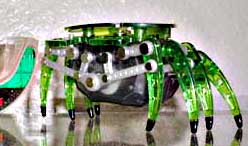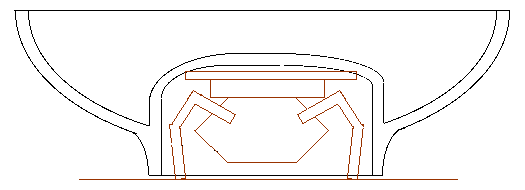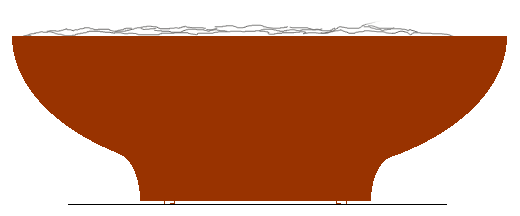A Wild Hare Idea Example
Here’s an example of a Wild Hare Idea which started with a little battery powered “micro-bot” from HexBug (Hexbug,com) sold at Radio Shack.

Once turned on, this little critter crawls off, crab like, for two or three seconds, then stops. After 20 seconds to a minute or so, it scurries off again, sometimes in the direction it had been traveling, sometimes reversing its direction - and sometimes turning left.
If it makes its way into a dark area - it stops and waits - listening. You see, this device has a sound sensor on it, and circuitry to “listen” - for vibration - which is what sound is. Any sudden sound, like hands clapping, or it’s floor moving suddenly - due to a near by footstep - will send it scurrying off again. Think cockaroach, in a crab like body.
The Wild Hare Idea?
How about hiding this thing in the underside of a turned piece which, when “startled”, scurries away - then stops, waiting - and listening - scurrying off again at the sound of a hand clap, or a tap on it's support surface?
In order to pull this off, the piece has to meet several critical criteria.
First, the piece has to be of a size that can hide the micro-bot inside.
Second, it has to be light enough for the micro-bot to be able to move it.
Third, it has to look pleasing enough to engage someone, preferably
like a familiar object since the goal is to surprise, and maybe delightFourth, the piece has to be turnable - preferably out of one piece of wood
- no added micro-bot compartment “insert”
Now the first criteria can be worked out with a measuring tape to get how big the micro-bot is and how much room the legs need to move. A little work with pencil and paper, starting with the bot space requirements, draw some curves, do a bunch of erasing and redrawing - and Criteria One can be met.
Criteria Three and Four can take a lot more erasing, trying another combination of lines, erasing some, redrawing . . . - all the while keeping in mind that the piece must be turnable.
It’s Criteria Two that requires the leap of faith. Meeting the weight criteria will require CAREFULLY and incrementally removing wood - without - BLOWING THROUGH THE SIDES - OR BOTTOM - with no guarantee that the piece can, in fact, be made light enough without making it too delicate to be practical.
(NOW he wants to introduce being practical?! He’s trying to combine a turned wooden bowl - with essentially the behavior of a cockaroach - and is worried about the results being - practical!?).
The “simple” solution would to follow the K.I.S.S. (Keep It Simple STUPID) approach. A plain turned bowl, with a little bit wider than necessary foot in which to hide the critter - like this

Now the skeptics will say “But you can see the big bump inside the bowl. That'll never convince anyone that this is just a simple bowl.”
Well I have a solution to THAT problem - micro balloons. Model plane builders - no not the plastic model jets - the balsa wood model planes makers - use epoxy and micro balloons as filler. The micro balloons are tiny glass bubbles that, while filling space, weigh almost nothing - cause they’re hollow.
Pour in enough micro-ballons to cover the top of the critter compartment and you’ve got a sugar bowl, or more accurately, a bowl - full of what LOOKS like sugar.
